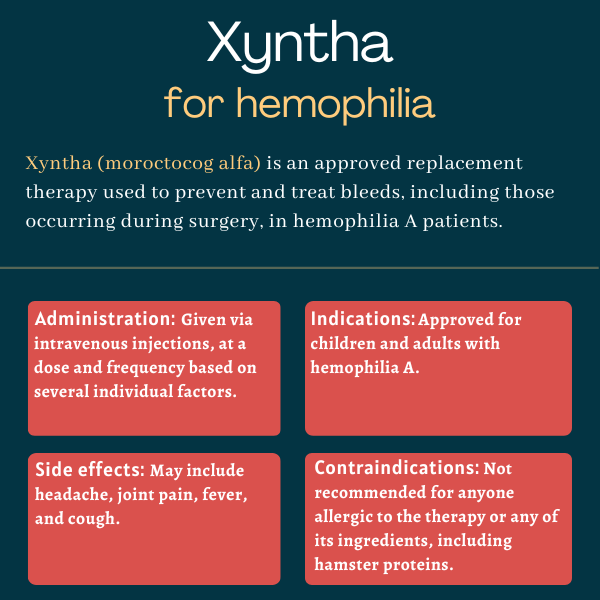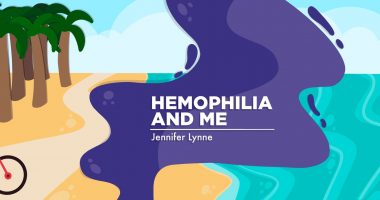Xyntha (moroctocog alfa) for hemophilia
What is Xyntha for hemophilia?
Xyntha (moroctocog alfa) is a recombinant, or man-made, clotting factor replacement therapy approved to prevent and treat bleeds, including those occurring during surgery, in people with hemophilia A.
It was originally developed by Wyeth Pharmaceuticals and is now marketed by Pfizer, which acquired Wyeth in 2009. The therapy is administered via an intravenous (into-the-vein) injection.
Therapy snapshot
| Brand name: | Xyntha |
| Chemical name: | Moroctocog alfa |
| Usage: | Prevention and treatment of bleeding episodes, including those occurring during surgery, in hemophilia A patients |
| Administration: | Intravenous injection |
How does Xyntha work?
In hemophilia A, mutations impair the production or functionality of clotting factor VIII (FVIII), a protein that plays a key role in blood clotting, resulting in prolonged and excessive bleeding.
Xyntha contains a lab-made version of this protein that can be administered to people with hemophilia A to make up for the missing FVIII and restore normal blood clotting.
The version of FVIII used in Xyntha is manufactured using a genetically engineered Chinese hamster ovary (CHO) cell line, so it may contain traces of hamster proteins.
Who can take Xyntha?
Xyntha was first approved by the U.S. Food and Drug Administration in February 2008 as an on-demand treatment to control bleeding episodes and to manage bleeds occurring during surgery.
In August 2020, that approval was extended to include its use as a routine prophylactic treatment to reduce the risk of bleeding episodes. Xyntha’s current indications in the U.S. cover its use in both adults and children with hemophilia A.
Refacto AF, a therapy that has the same active ingredient as Xyntha but is manufactured with a different potency, also is approved in Europe for the treatment and prevention of bleeding episodes in hemophilia A patients of all ages. The two products are not interchangeable.
Who should not take Xyntha?
Xyntha is contraindicated, or not recommended, to anyone who has experienced a serious allergic reaction to the therapy or any of its components, including hamster proteins.
The therapy also is not indicated for the treatment of von Willebrand disease, another blood clotting disorder.
How is Xyntha administered?
Xyntha is given intravenously and may be self-administered after appropriate training by a healthcare provider.
The medication is available as a dry white to off-white powder that comes in single-use vials. There are four available strengths, which are color-coded:
- Yellow contains 250 international units (IU) of FVIII.
- Blue contains 500 IU of FVIII.
- Green contains 1,000 IU of FVIII.
- Red contains 2,000 IU of FVIII.
It must be reconstituted, or diluted, in a supplied liquid solution before it can be administered into the vein. Administration usually takes several minutes, depending on a patient’s comfort level.
The therapy is also available in a kit with a prefilled dual-chamber syringe, known as Xyntha Solofuse, that contains both the powdered therapy and the liquid to dilute it. Xyntha Solofuse kits are available in five dosage strengths that are also color-coded:
- Yellow contains 250 IU FVIII.
- Blue contains 500 IU of FVIII.
- Green contains 1,000 IU of FVIII.
- Red contains 2,000 IU of FVIII.
- Gray contains 3,000 IU of FVIII.
The appropriate dose and duration of treatment will be determined by a healthcare professional based on the patient’s age, body weight, and clinical condition, as well as on the type of bleed, bleeding severity, and degree of FVIII deficiency.
For routine prophylaxis, or preventive treatment, Xyntha’s recommended starting dosage is:
- 30 IU per kilogram of body weight, three times weekly, for patients ages 12 and older
- 25 IU per kilogram of body weight, every other day, for children younger than 12.
The dosing and frequency of prophylactic injections may be altered based on a patient’s response. According to the therapy’s label, higher doses or more frequent administrations may be required in children younger than 12, due to the higher speed at which the medication is cleared from their body.
For on-demand treatment, Xyntha is recommended to be given to maintain FVIII activity levels at:
- 20 to 40 IU/dL, with dosing every 12-24 hours for at least one day, depending on bleeding severity, in the case of minor bleeds (e.g., minor muscle or oral bleeds)
- 30 to 60 IU/dL, with dosing every 12-24 hours for three to four days or until bleeding is under control, in the case of moderate bleeds (e.g., muscles bleeds, mild head trauma)
- 60 to 100 IU/dL, with dosing every 8-24 hours until bleeding is resolved, in the case of major bleeds (e.g., fractures, bleeding in the brain or gastrointestinal tract).
For minor surgical procedures, such as tooth extraction, Xyntha should be given every 12-24 hours for three to four days or until bleeding is under control. The aim is to maintain FVIII activity levels at 30 to 60 IU/dL. In the case of tooth extraction, a single dose of Xyntha given in combination with an antifibrinolytic agent within one hour may be sufficient.
For major surgical procedures, Xyntha should be given every 8-24 hours until bleeding is under control and healing is achieved, to maintain FVIII activity levels at 60 to 100 IU/dL.
Patients wishing to self-administer Xyntha should follow the specific instructions given by their doctor. Detailed instructions for preparing and administering Xyntha and Xyntha Solofuse can be found in Pfizer’s labeling.

Xyntha in clinical trials
The safety and efficacy of Xyntha as an on-demand, prophylactic, and perioperative — given around the time of surgery — treatment for hemophilia A were demonstrated in three multicenter open-label clinical trials involving a total of 174 previously treated patients.
On-demand treatment
To test the therapy for on-demand use, a clinical trial enrolled 94 people with hemophilia A, ages 12 and older. All were receiving Xyntha as a routine prophylactic treatment, but the therapy also could be used on-demand to manage bleeds when they occurred. A total of 187 bleeding episodes were treated in 53 of these patients.
The vast majority (93%) of these bleeds resolved after just one or two infusions of Xyntha. The response to Xyntha was rated as “good” or “excellent” in 71% of all treated bleeds. Another 24% were rated as “moderate,” while the rest were either not rated (3%) or showed no response to treatment (3%).
In another study that enrolled 50 children ages 12 and younger, 38 were given Xyntha for on-demand management of 562 bleeding episodes. The majority of these bleeds (92%) resolved after one or two infusions of Xyntha. The therapy’s efficacy was rated as “good” or “excellent” in nearly all cases (94%), with 5% being rated as “moderate.”
Use in surgery
In another trial, Xyntha was used for perioperative treatment to control bleeding during surgery in 30 people with hemophilia A. Among the 25 patients with available efficacy data, the efficacy of the therapy at controlling bleeds at the end of surgery was rated as either “excellent” (72%) or “good” (28%). When patients were discharged or reached the sixth day after surgery, whichever occurred later, Xyntha’s efficacy at controlling surgical bleeding was rated “excellent” in 92% of the cases, and “good” in 8%.
Prophylaxis
Routine prophylactic treatment with Xyntha was evaluated in 94 hemophilia A patients ages 12 and older, as well as in eight children younger than 12, as part of two distinct studies.
Among older patients, mean annualized bleed rates were 88% lower in patients who received prophylaxis with Xyntha compared with those given the therapy for on-demand treatment alone before switching to the prophylactic regimen. Nearly half of these patients (45%) reported no bleeding with routine prophylaxis.
Findings in younger patients were similar: mean annualized bleed rates reduced by 97% in children given prophylactic Xyntha compared with those on on-demand treatment, and half of the children on preventive treatment remained bleed-free.
Common side effects of Xyntha
The most common side effects of Xyntha reported in clinical trials include:
- headache
- joint pain
- fever
- cough.
Allergic reactions
Allergic reactions, including serious reactions known as anaphylaxis, may occur in patients receiving Xyntha. Symptoms of an allergic reaction may include an itchy rash or hives, wheezing, chest tightness, and low blood pressure. If an allergic reaction occurs, Xyntha should be stopped immediately and appropriate treatment given to manage the reaction.
Development of inhibitors
In some patients, the immune system can mistake the clotting protein in Xyntha for an infectious threat and produce neutralizing antibodies, called inhibitors, against it. Patients should be regularly monitored for the development of FVIII inhibitors, especially if treatment does not elicit the expected response.
Use in pregnancy and breastfeeding
There are no available data on the use of Xyntha during pregnancy or while breastfeeding. Therefore, it’s not known if the therapy can be harmful to a developing fetus, pass to breast milk, or have a negative effect on breastfed infants.
In these situations, patients and their care teams should evaluate the potential risks and benefits of using Xyntha to make an individualized decision on whether to continue or stop treatment.
Hemophilia News Today is strictly a news and information website about the disease. It does not provide medical advice, diagnosis or treatment. This content is not intended to be a substitute for professional medical advice, diagnosis, or treatment. Always seek the advice of your physician or other qualified health provider with any questions you may have regarding a medical condition. Never disregard professional medical advice or delay in seeking it because of something you have read on this website.
Recent Posts
- Liver rupture leads to hemophilia B diagnosis in newborn: Case report
- One woman’s path to a black belt — and hemophilia diagnosis
- Doctors warn eye bleeding can be first sign of hemophilia A
- I’m still learning how to ask for help ahead of an important surgery
- Gene therapy can help reduce joint bleeds in hemophilia B: New data
Related articles

 Fact-checked by
Fact-checked by 



